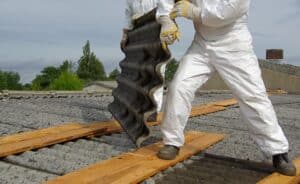What Buildings Have Asbestos?
 Before the use of asbestos was banned, it was widely used throughout the construction industry. Although the health hazards of asbestos became well-known in the 1980s, it wasn’t until 1999 that chrysotile, or white asbestos, was banned in the UK. Due to this, any buildings constructed before the year 2000 are highly likely to contain some form of asbestos.
Before the use of asbestos was banned, it was widely used throughout the construction industry. Although the health hazards of asbestos became well-known in the 1980s, it wasn’t until 1999 that chrysotile, or white asbestos, was banned in the UK. Due to this, any buildings constructed before the year 2000 are highly likely to contain some form of asbestos.
The use of blue asbestos and brown asbestos was banned in the UK in the mid-1980s, so buildings constructed after this time shouldn’t contain either of these substances. However, white asbestos was still in use until 1999, although it was more heavily regulated between 1992 and 1999.
Is Asbestos Still Present in Buildings?
 Yes. Asbestos is still present in both industrial and residential buildings in the UK and in other parts of the world. When the UK banned the material from being used, it prohibited the ‘new use’ of asbestos, which means asbestos that was already present in buildings didn’t have to be removed. Due to this, buildings constructed before 1985 are likely to contain white, blue, and brown asbestos, while buildings constructed between 1985 and 2000 are likely to contain white asbestos.
Yes. Asbestos is still present in both industrial and residential buildings in the UK and in other parts of the world. When the UK banned the material from being used, it prohibited the ‘new use’ of asbestos, which means asbestos that was already present in buildings didn’t have to be removed. Due to this, buildings constructed before 1985 are likely to contain white, blue, and brown asbestos, while buildings constructed between 1985 and 2000 are likely to contain white asbestos.
Where Is Asbestos Most Common?
Asbestos was heavily used throughout the construction industry, which means it’s present in various forms within most buildings. In industrial buildings, such as factories or offices, asbestos can often be found in the following environments:
- Inside walls and attic spaces as loose fill insulation.
- Sprayed on to walls and ceilings as a coating.
- As lagging on pipes and boilers.
- As asbestos insulation boards (AIB) in partition walls and in AIB fire doors.
- On roofs and gutters in the form of asbestos cement.
- In vinyl floor tiles.
In residential homes, asbestos was commonly used as:
- Pipe lagging.
- Decorative wall and ceiling coatings (e.g. Artex).
- AIB ceiling tiles.
- AIB airing cupboards.
- Loose fill insulation.
- AIB bath panels.
- AIB interior window panels.
- Vinyl floor tiles.
- Asbestos cement gutters and downpipes.
- Roofs, roofing felt, and exterior window panels.
- Spray-on insulation coatings.
Is Asbestos Dangerous?
Asbestos is considered to be highly dangerous and interacting with the material can cause people to develop serious medical conditions, such as mesothelioma. However, asbestos is not believed to cause health problems if it is left untouched. Instead, it only becomes dangerous if it’s disturbed or removed. That’s why it’s important that you can confirm whether asbestos is present in your home and/or workplace and seek professional assistance before attempting to remove or modify it.
